Mega Wave - Towards a New Synthesis
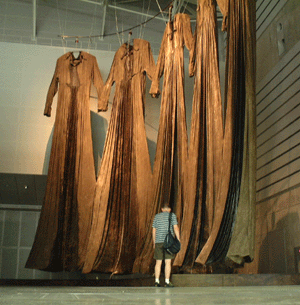
The big wave rolled into Yokohama on the weekend. Not the feared
Tsunami but a wave of art, artists and creativity has flooded the seaport
area. Works of art by more than 100 artists from around the world are
exhibited in two main venues in the Minato Mirai port district in Yokohama.
This is Japans largest exhibition of contemporary art and it is the first
in a regular three-year cycle.
Most known forms of art are included in the exhibition -- except perhaps
oil painting. Following a worldwide trend in contemporary art, video and
the new media arts dominate this exhibition. However, they are presented
in such variety that they are also the surprises and exhibition highlights.
Video has been used to document events, display hand drawn animations,
record scientific observations, manipulate appropriated television images
and present computer generated imagery.
A video highlight would include the strangely graceful but at the same
time ridiculous attempts of people to ride rickshaws underwater. This
was part of an enigmatic video by Vietnamese artist Jun Nguyen-Hatsushia
and includes a symphonic sequence of underwater shots recording an installation
of mosquito nets attached to corral and rock outcrops. Also dealing with
the sea is Allan Sekula, a U.S. artist who has pioneered an artform including
new media such as video and photography to record and document aspects
of culture and history. His work in the exhibition is a research project
oscillating between Tsukiji fish market and the US naval base in Yokohama.
It includes video and photography as well as historic documents and other
research.
Fiona Tan who lives and works in the Netherlands is another who explores
tensions between cultures in her piece titled Saint Sebastian. Video projections,
on two sides of a screen hanging in the room, shows the concentration
on faces of young Japanese women doing Kyudo, traditional archery. The
camera studies their Kimono and faces in state between calm and tension
as they shoot. Although we hear the arrows let fly we neither see no hear
their target. The title, in reference to the Christian saint martyred
by being shot with arrows adds an extra tension.
The absurdest performances by Orimoto Tatsumi known as The Breadman, are
photographed and presented as video documents. In these performances Orimoto,
wearing a bakers shop dozen French sticks tied to his head, delights
and perplexes passerbyes as his Dadaist artform interrupts the bustle
of modern life. His more recent work involving his Alzheimer suffering
mother uses tiny LCD screens to display videos capturing aspects of their
life and his art.
In other very different use of video as art, the rear of a tiny medicine
chest is used to screen the expressive animations of the South African,
Artist William Kentridge. Life is seen under a powerful microscope and
projected via video to a large screen and onto the Internet in Brazilian
Eduardo Kacs scientific yet poetic installation about genetics. While
in Korean artist, Sowon Kwons piece, television images of Olympic gymnasts
are manipulated by sketchy graphics, to highlight movement and space in
the imagery.
Born in Poland but now living and working in the U.S., Krzysztof Wodiczko
has made art focussed on social issues. 'The Tijuana Projection is a
video record of an outdoor art event where the extreme close-up of a young
woman is projected onto the side of a building. Chinese artist Xing Danwen
uses two video projects of landscapes in his piece 'Sleep Walking. One
video is back projected onto the bottom of a glass chest Ð the locks and
edges of which are brass antique styled fittings.
Also dealing with romantic notions of landscape and in a nod to the seductive
qualities of film over projected video, Tacita Dean exhibits a loop of
16mm film. We join the gentle clutter of a Berlin restaurant interior
high in the TV tower as it revolves allowing panoramic vistas of a blazing
setting skyline.
Australian artist STELARC explores the limits beyond the human body offered
by robotics. His large six-legged pneumatic robot is on display together
with a dramatic video of him at its controls during a performance. Also
in a scientific mode, Mats Bigert and Lars Bergstrom, Swedish artists,
project their video relating to climate change on a dome shaped screen.
Visitors step into a futuristic world of 3D images in Fujihata Masakis
computer generated work. Wearing special 3D glasses makes the photographic
projection surround the viewer who is then entwined in a maze of graphic
lines. In a dramatic demonstration of his suicide kit Japanese artist
Aida Makoto steps off a stool with the strappy apparatus attached around
his neck. Viewers can endlessly watch this moment captured on video as
they examine the actual suicide belt -- equipped with cell phone, last
glass of sake, and a snack, in chilling reality.
Many of the works in the Triennale incorporate video into complex installations,
however, Joelle Cionas work allows visitors to man the video camera to
spy on her building a web-like art installation hidden behind the wall.
By use of closed circuit video visitors can witness the progress of this
installation or by voyeuristically peering through spy holes strategically
placed in the wall. This survivor art seems particularly poignant in
this era of reality TV.
This is just a sampling of a few of the many works, which use moving images
to paint a new vision of artistic exploration. There are also some weighty
contributions to contemporary art, which do not use video. Yoko Onos
war torn bullet-riddled freight train, on display in front of the Red
Brick Warehouse space is a forceful example. Emanating from the train
is a blinding white light and the cries of forgotten souls. In this case
reminding me of the works neglected in this review of the tangible artists,
the creators of sculpture and installations, who also cry out for recognition.
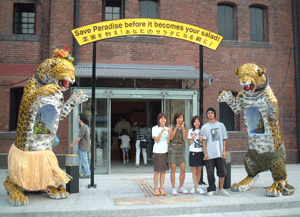
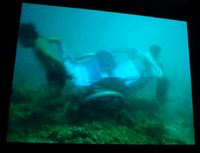

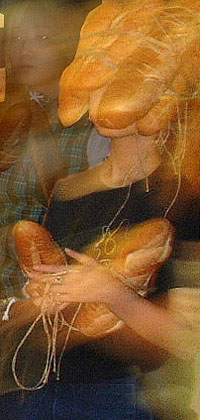

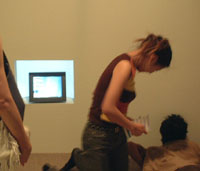
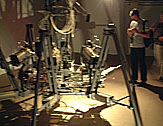
Tel: 045.223.6444
Pacifico Yokohama Exhibition Hall Red Brick Warehouse No 1
Yokohama seaside district Minato Mirai 21 Sakuragi-cho station JR Keihin Tohoku Line
10:00 - 18:00, Friday - 20:00 Closed on Sep. 11 (Tue.), 25 (Tue.), Oct. 9 (Tue.), 23 (Tue.) Adults Y2000, Children Y500
http://www.jpf.go.jp/yt2001/